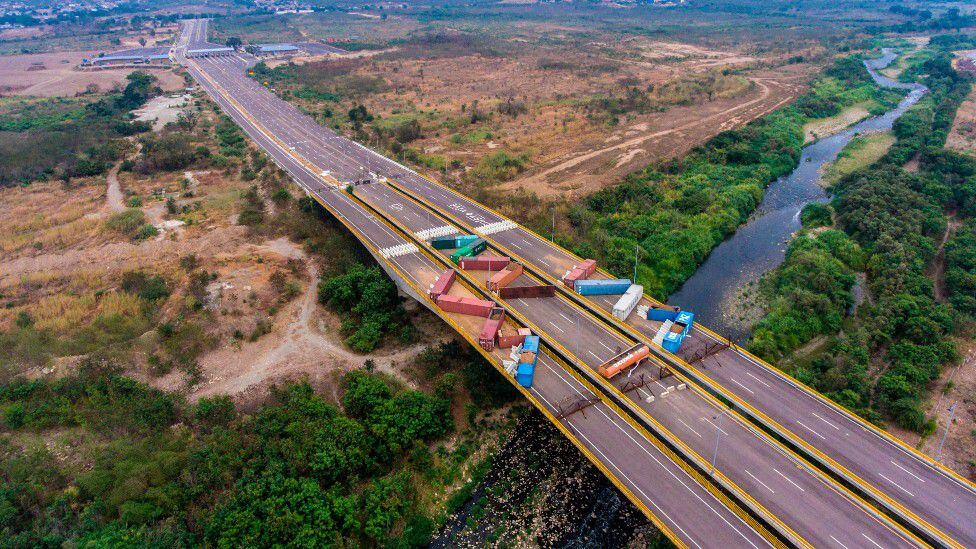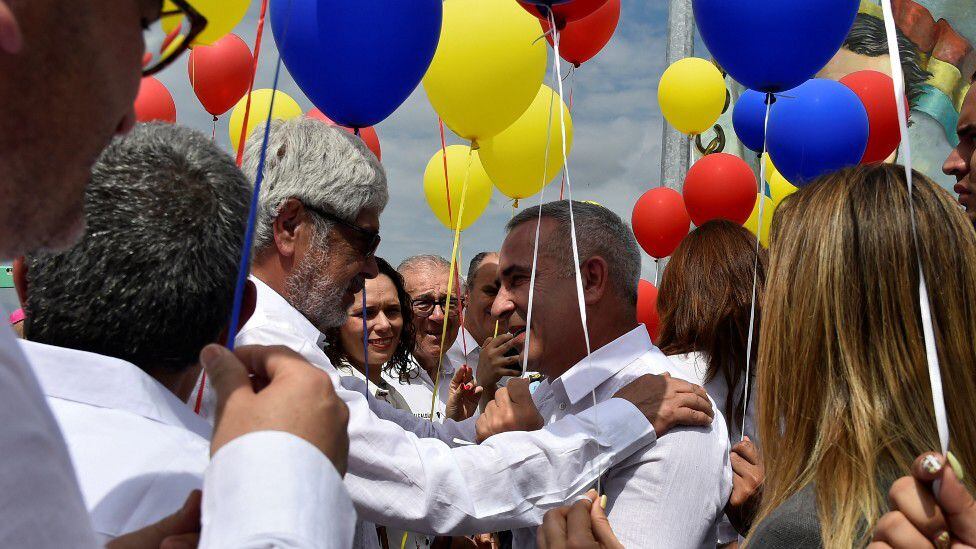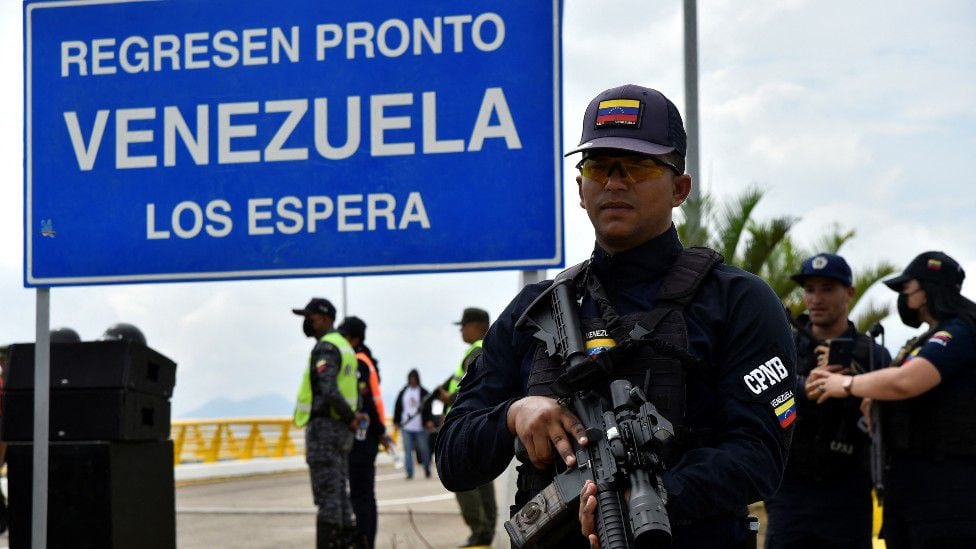Seven years have passed since it was finished, 10 since construction began and more than 30 since it was devised so that, finally on January 1, the Tienditas international bridge, between Colombia Y Venezuelawould open
And with a new name: Atanasio Girardot International Bridgein homage to a hero of the independence of both countries.
SIGHT: How Venezuelan migrants improve the economy of the countries that receive them
The closure of the border in 2015, decreed by Nicolás Maduro in the midst of an altercation with the then Colombian president Juan Manuel Santos, was the last of the obstacles: before that there were dozens of disagreements between Bogotá and Caracas that hindered the project for decades.
With three platforms with three lanes each, a crosswalk for pedestrians and another for bicycles, this It is the first large-span bridge on a 2,200-kilometre border in which millions of people live from the daily passage from one side to the other.
“This generates a lot of optimism because it is part of our DNA, our history, our tradition,” says Armando Peña, president of the Chamber of Commerce of Cúcuta, the main border city on the Colombian side.
“As a single territory we join the historical, cultural and social brotherhood that has always identified us,” said Freddy Bernal, Chavista governor of Táchira state.
Euphoria was the common sentiment of those present at Sunday’s opening event, but skepticism, not just about the bridge but the border in general, remains high.
“Much was destroyed during the lockdown and much remains to be fixedbut for many here, including Venezuelan officials, there is a willingness to work together towards the normalization of a border that should never have been closed,” said a senior Colombian official who was at the event and asked not to be identified as he was not a spokesperson. .
Ronald Rodríguez, a researcher at the Observatory of Venezuela at the Universidad del Rosario, in Bogotá, added: “The opening of the bridge is good news, but the way it happened, the authorities were left in an almost ridiculous position, because the level of coordination between them is almost nil; people don’t know what changes and how it benefits them“.
Coordination is one of the key words of the matter: that the immigration, road, commercial, judicial and police authorities of both countries are on the same page so that the bridge and the border work well.
There are many pending challenges. There are already commercial flights between Bogotá and Caracas, for example, but they are limited and expensive. The restoration of relations is underway, but it is going slowly.
Here we summarize three of the most important challenges after the reopening of the border.
1. Regularize the step
It is one thing for the Atanasio Girardot bridge to be open and another for it to be efficient.
Much depends on the guidelines established by the authorities for transit, which are not entirely clear.
The governments gave until January 9 for private cars to pass without restrictions, but since then it is expected that they must meet a series of requirements.
Venezuelan cars in Colombia will have to take advantage of the vehicle restriction system known as “pico y placa”.
The cars will have to pay the Mandatory Traffic Accident Insurance (SOAT) in Colombia and the Liability Insurance Policy in Venezuela.
It is not clear, however, whether Venezuelans will be able to put gasoline in Colombian stations, where there is a much larger supply than there is in Venezuela and in certain cases provide fuel at a subsidized price.
At Atanasio Girardot there is still no police station, public transport vehicles are not allowed and on the other two bridges in the area, Francisco de Paula Santander and Simón Bolívar, there is still no free passage for cars.

2. The identification (and rights) of the pendular migrant
Beyond crossing the bridges, the reopening of the border implies challenges in other, perhaps more complex issues.
For example, the statute under which those who pass from one place to another almost every day are governed: the so-called pendulum migration.
There is a Border Mobility Card (TMF) for Venezuelans going to Colombia. But on the Venezuelan side there is no such thing.
Rodríguez, from Bogotá, explains: “This card, which 4.9 million Venezuelans have, was created in 2016 to manage flows, but it is not an identity document and that creates problems, because does not allow them to formally receive health or educational services in Colombia“.
Only in Norte de Santander, the most important border department, between 2017 and 2022 health services attended more than two million people coming from Venezuela, according to official figures.
But, since they did it informally and without the Colombian system looking at them, it was a poor service.
The same thing happens with education.
“Must generate instruments so that Venezuelan children from the border can go to school in Colombia without having to lie [alegando que viven en Colombia] and prevent them from committing a violation,” says Rodríguez.
The Rosario Observatory estimates, based on official reports, that in 2021 at least 5,000 children living in Venezuela went to school in Colombia. With the border closed.
And financial services must also be regulated, since the TMF does not give rights to Venezuelans who come to Colombia to open a bank account, forcing them to resort to informality.
And they can’t get a Colombian cell phone line either.

3. Reactivate bilateral (and legal) trade
The great challenge for Bogotá and Caracas is to return to the bilateral trade numbers of 10 or 15 years ago, according to the experts consulted.
In 2008, for example, trade between the two countries was US$7.2 billion and the annual average was approximately US$2.3 billion per year.
In 2021 the figure stood at US$300 million, the lowest in recent history. And in 2022, after the partial opening of the border on September 26, it rose to almost $800 million for the entire year.
The Colombian Minister of Commerce, Germán Umaña, has said that the goal is for the figure to double by 2023 and from then on it will follow an upward path.
An analysis by the National University of Colombia estimated that the opening of the Atanasio Girardot bridge can contribute US$300 million to the binational exchange.

But there are several obstacles: Colombia and Venezuela do not have comprehensive trade agreements, there are unclear sanitary and customs requirements and, perhaps most important, Venezuela is not part of the Andean Community (CAN), a corporation that facilitates exports between countries in the region.
“Without the CAN, the reactivation of international trade is going to be very difficult and we will have to see how the actors that dominate the area react,” says Rodríguez.
And it is that Colombian officials have said that during the closure of the border the number of armed groups present in the area multiplied.
And, therefore, the incidence that these groups had in the legal and illegal economies increased, as reported by specialized study centers such as the Crisis Group.
The challenge for the authorities is to take away those businesses. That is the biggest challenge.
Source: Elcomercio
I am Jack Morton and I work in 24 News Recorder. I mostly cover world news and I have also authored 24 news recorder. I find this work highly interesting and it allows me to keep up with current events happening around the world.

:quality(75)/cloudfront-us-east-1.images.arcpublishing.com/elcomercio/OMMA7BXWNFDF5FVZP642AEMEIM.jpg)

:quality(75)/cloudfront-us-east-1.images.arcpublishing.com/elcomercio/NKMUUVS7ZNDVZATFWMR3S333LI.jpg)

:quality(75)/cloudfront-us-east-1.images.arcpublishing.com/elcomercio/7CQB22YK5NHTPCCGZCZELGGBFY.jpg)

